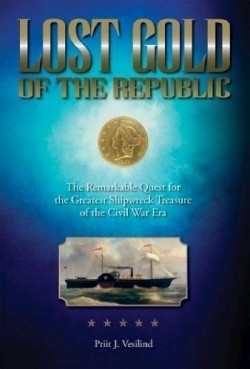Lost Gold of the Republic
- 2005 INDIES Finalist
- Finalist, History (Adult Nonfiction)
On October 25, 1865, the ocean bottom a hundred miles off the coast of Georgia received a tribute of $400,000 in gold and silver coins, many of them $10 and $20 eagles and double eagles. Ironically, the coins were on their way home to New Orleans where they had been minted. It would be one 139 years before human eyes would see them again, and then only because they were seen first by the mechanical eye of a camera mounted on a submersible robot.
History affirms that the twice re-named paddle-wheel vessel, Republic, had left from New York Harbor for New Orleans with fifty-nine passengers, 500 barrels of freight, and a fortune in currency. The goods and the coins were expected to go a long way toward the first efforts in recovery of the economy and banking industry of a South devastated by the Civil War. Reports from survivors share the human drama of a sudden hurricane that sent the ship to her final landing.
It’s hard to isolate which are the most engaging themes offered for a reader’s enjoyment and education. Economists will relish the details of the economic and sociological ramifications of the American Civil War. Historians will recognize and enjoy not only the geographical outline, but the elegant decadence of nineteenth-century New Orleans society. Every reader will thrill to the robust retelling of the terror that assailed crew and passengers in a howling storm, and their despair as they were loaded into a few lifeboats and one flimsy raft, all launched in forty-foot seas.
Perhaps the most novel and unfamiliar aspect of the story details the struggles of modern shipwreck salvors with government, academia, and competitors; and the burgeoning interest in and industries supporting deep water exploration. Most heartening of all is not only the passionate determination of two men but their success in proving that they could do the impossible, make money at it, and defy the refusal of traditional archaeologists to believe that a commercial salvor could serve science as well as Mammon.
The author is a writer and researcher for National Geographic. He has written this book so persuasively that his intricate weaving together of the story hangs together in a seamless forward movement that lays out a stretch of time covering close to a century and a half as though it were all existing simultaneously in one plane.
Readers of the National Geographic article about the recovery of the Republic in 2004 will be even more excited by this expanded version. The intensive research of Vesilind and his aides, his actual experience on the salvage vessel, and the photographs taken with the assistance of magazine staff, bring this many-pronged adventure story to a level of reality hard to resist.
Reviewed by
Sandy McKinney
Disclosure: This article is not an endorsement, but a review. The publisher of this book provided free copies of the book to have their book reviewed by a professional reviewer. No fee was paid by the publisher for this review. Foreword Reviews only recommends books that we love. Foreword Magazine, Inc. is disclosing this in accordance with the Federal Trade Commission’s 16 CFR, Part 255.

